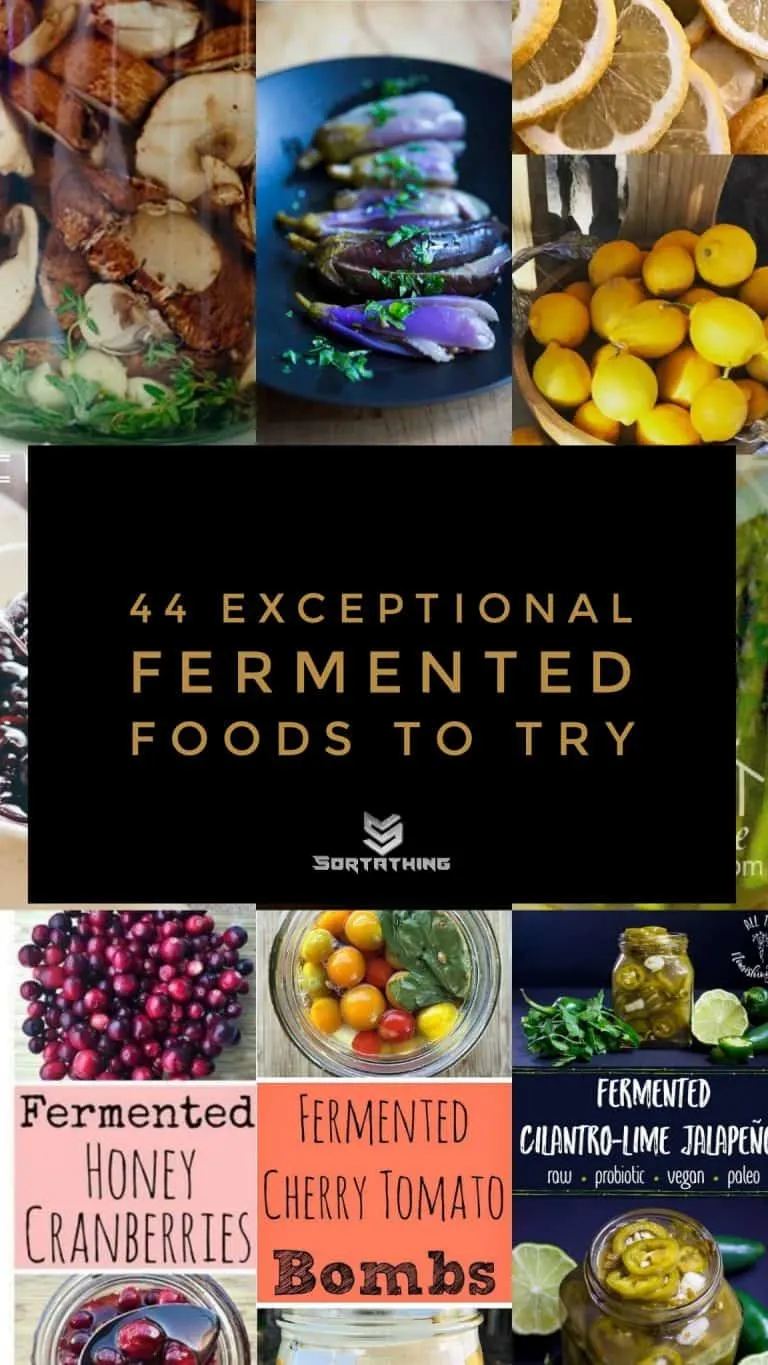Fermented foods are a great way to store excess produce but they also have many health benefits.
They’re rich in vitamins and usually high in fiber. Fermentation produces compounds that fight cancer, could help you lose weight and fight off allergies, inflammation and other chronic autoimmune conditions.
They also reduce cravings and lower LDL levels (though that might not always be a good thing, the link between high LDL and poor health is not at all strong).
Fermented foods and a healthy microbiome
Living with a healthy microbiome is a hot topic. Research is uncovering a vast and varied network of microbes at work in all our bodies. Eating the wrong foods can disrupt how they work together and cause physical and even mental illness.
An excellent way to keep your microbiome in shape is to eat fermented foods. There are many to choose from besides the usual pickles, kimchi and yoghurt, including some really unusual foods you might not dream of fermenting.
Fermented guacamole, mayonnaise and roasted potatoes, anyone? They’re all here!
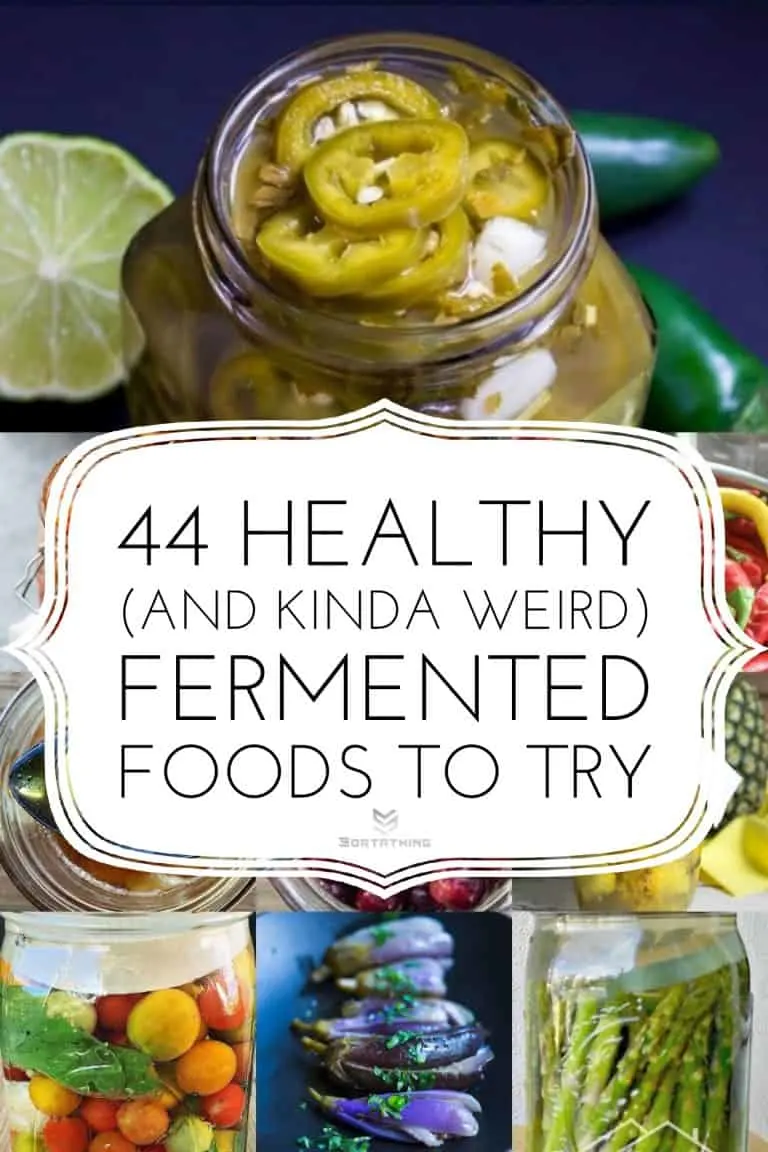
Article image from Feasting at Home
1. Clabber Milk – why you should eat it and how to make it
Clabber milk is a naturally fermented milk product that can be eaten raw or used in recipes. Raw cow’s milk is full of naturally occurring beneficial Lactic Acid Bacteria and when it’s supported with a warm environment it will ferment, creating something similar to a cross between yoghurt and kefir.
If left to ferment long enough the clabber milk will separate into curds and whey.
From: Butter for all
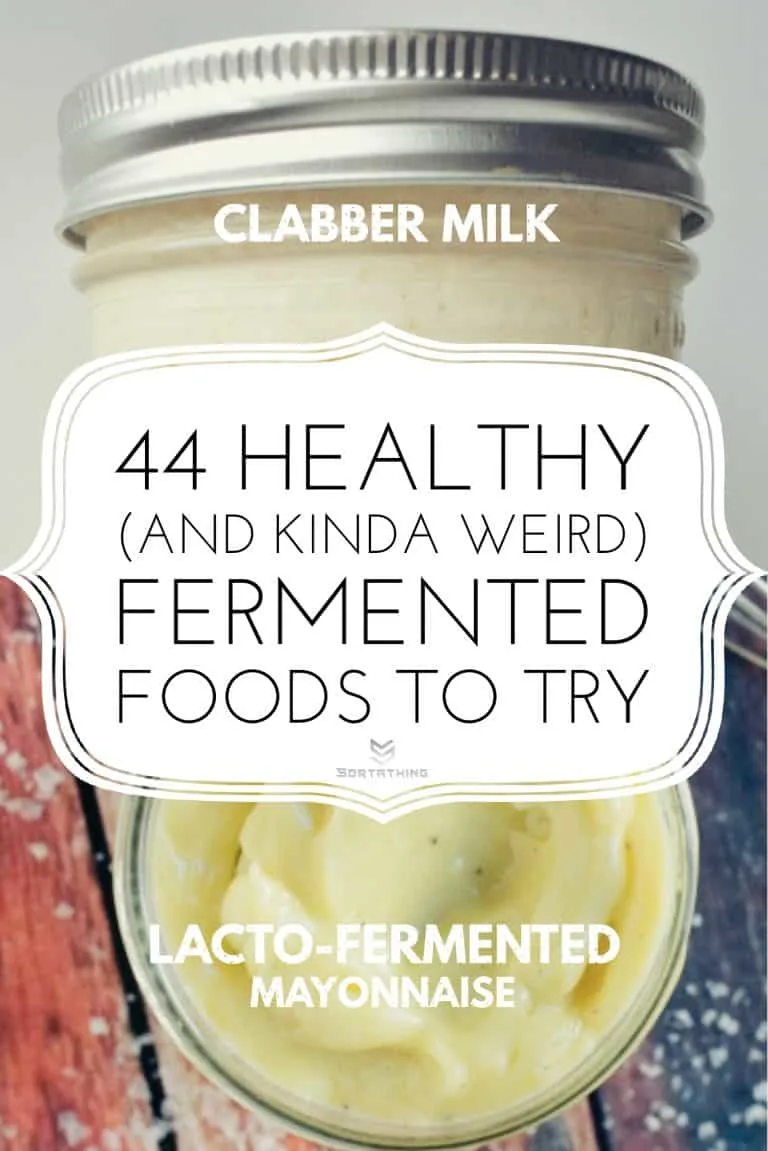
Clabber Milk & Lacto-Fermented Mayonnaise
2. Golden Beet & Turmeric Kvass
Kvass is a delicious fermented drink originating in Russia. Traditionally, kvass was made with fermented sour dough rye bread, creating a probiotic drink with a very low alcohol content that tasted similar to beer with amazing health benefits.
These days beet kvass has become another traditional fermented drink option, with undeniable medicinal and health benefits
From: Healing Harvest Homestead
3. Lacto-fermented Mayonnaise
Culturing is one of the oldest methods of food preservation, traditionally used to stockpile food for the long winter months, and culturing your homemade mayonnaise will greatly increase its storage time.
Uncultured mayonnaise will only keep for a few days in the fridge before it starts to break down and separate. Yet I have discovered month-old cultured mayonnaise hiding in my fridge that was still perfectly edible.
From: The Cook’s Pyjamas
4. Homemade Fermented Pineapple Vinegar
It’s always a treat to make this vinegar with left-over pineapple scraps. It’s a great way to use the entire fruit after you’ve eaten the delicious flesh and a fantastic means to get more probiotic-rich fermented foods into your diet.
From: Omnomally
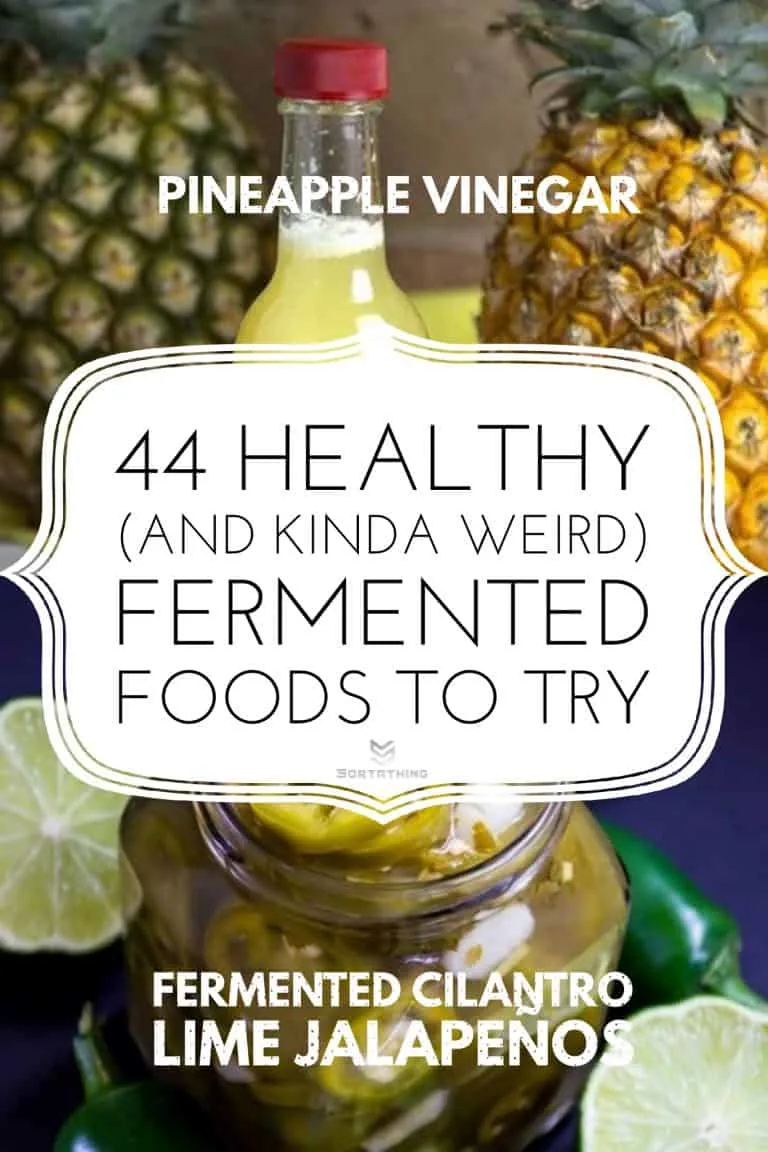
Fermented Pineapple Vinegar & Fermented Cilantro Lime Jalapenos
5. Fermented Cilantro-Lime Jalapenos
Preserve summer’s harvest of jalapeño peppers and add gut-healthy probiotics to your Mexican-inspired meals with Fermented Cilantro-Lime Jalapeños!
These probiotic peppers are totally raw, vegan, paleo, keto, and Whole30, perfect for topping healthy tacos, nachos, fajitas, and more!
From: All The Nourishings
6. Fermented Cherry Tomato Bombs
The main trick to this recipe is to use tomatoes that are not fully ripe. The problem with fermenting ripe tomatoes is that the sugars in them want to turn to alcohol. These cherry bombs will continue to gain effervescence even under refrigeration. The pressure is not in the jar, but in the tomatoes themselves!
From: Grow Forage Cook Ferment
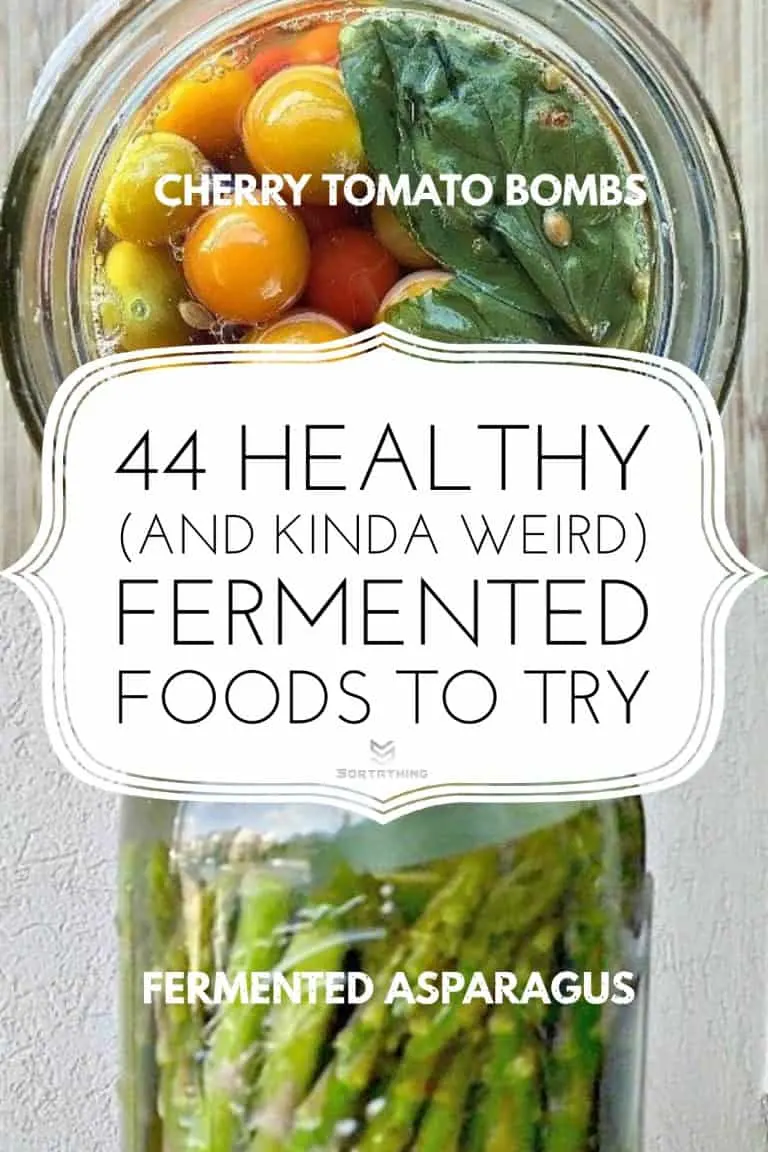
Fermented Cherry Tomato Bombs & Pickled Asparagus
7. Fermented Pickled Asparagus Recipe
Like any other fermented food, pickled asparagus is extremely easy to make. Because asparagus has so many added health benefits, it is truly a superfood in my book. Asparagus is a great source of fiber and is loaded with vitamins A, C, E and K.
There are tons of trace minerals and micronutrients in asparagus, too. One of those trace minerals is chromium, which aids in the ability of insulin to transport glucose from the bloodstream into cells.
From: Survival at Home
8. Easy Naturally Fermented Apple Salsa
Apple salsa is super simple, so delicious and quite versatile! We love to eat it on its own, or thrown into a yummy grilled chicken salad. When fermented, it adds a host of beneficial bacteria and increases the nutrients naturally in the ingredients included.
From: Kitchen Stewardship
9. Fermented Roasted Potatoes
The best part about these potatoes is the texture. You know the texture of a really great, thick potato chip? Like when they have visible bubbles under the skin and the exact right bite?
Think of that transformed into roasted potatoes, with crisp exteriors and smooth, puffy insides. Plus, these potatoes have the added advantage of more complex flavor and, presumably, somewhat lowered sugar content.
From: Phickle
10. Fermented Honey Garlic
This tasty fermented garlic in honey can be used for many things, as good food and good medicine. Honestly, though, I like to just eat it as is! Making fermented honey garlic is so easy, it hardly needs a recipe. The hardest and most time-consuming part is prepping all of the garlic. Whatever size jar you use, you’ll want to fill it about 3/4 full of peeled garlic.
From: Grow Forage Cook Ferment
11. Lacto-fermented Zucchini Sticks
Why ferment cucumbers and squash, rather than just pickle them? Lacto-fermented vegetables are more nutritious and, I think, much tastier. Traditional fermentation yields extremely nutritious foods. In contrast, modern pickled foods are essentially dead.
From: Learning and Yearning
12. Lacto-fermented Jalapeno Peppers
These peppers are a staple in our fridge. My favorite way to eat them is on tacos, nachos, and salads. I usually buy a large batch of peppers towards the end of their growing season and preserve enough to last us through the next year. This recipe keeps them firm, yet tangy and spicy the entire time.
From: Prepare & Nourish
13. Fermented Honey Cranberries
It’s amazing to me that I’ve never done this kind of fermenting in honey before recently. I’ve done all kinds of fermenting, and have even fermented cranberries in a traditional brine. But for some reason, I had never fermented in honey. Well, I can tell you now that has changed!
From: Grow Forage Cook Ferment
14. Fermented Green Tomatoes
I got really excited when I saw a recipe for lacto-fermented green tomatoes because I have a ton of them and wasn’t sure what to do with them all! Ferment them, of course, what was I thinking?
These babies are darn tasty! Like dill pickles, but with a little more tartness.
From: Grow Forage Cook Ferment
15. Ginger & Turmeric Kombucha
Anti-inflammatory turmeric and gut-healing ginger combine powers in this lovely flavored kombucha! If you’re new to fermenting or keeping Mother cultures, Kombucha is a GREAT place to begin!
Basically, kombucha is sweet tea with an added SCOBY (symbiotic colony of bacteria and yeasts) that is fermented from 7 to 21 (or more) days, depending on the flavor and amount of sweetness you prefer. The longer the kombucha ferments, the less sugar it will contain!
From: All the Nourishings
16. How to make Fermented Lemons
I’ve tried preserving lemons before, but I didn’t like the way they turned out because the pieces were so large. I tried this fermentation experiment a little differently this time!
From: Healing Harvest Homestead
17. Sima: Finnish Fermented Lemonade
This drink, called “sima” is traditionally brewed in Finland on May 1 to celebrate the arrival of spring. It’s the easiest recipe I’ve ever seen for a home fermented beverage, with things that you probably already have in your kitchen.
From: Ever in Transit
18. How to make Fermented Eggplant
I’m going to share an AMAZING Fermented Eggplant Recipe that I think you’ll love! It makes a fantastic garnish, or you can even cook it into other foods like stews and casserole
From: Healing Harvest Homestead
19. Moroccan Pickled Eggplant
The last of summer eggplant are pickled for long keeping, in the Moroccan tradition. Eggplants are slit lengthwise, crisscross, with stems still attached, then simmered in a savory pickling liquid infused with garlic cloves and whole coriander seeds until meltingly tender.
Before serving, drizzle with a good quality olive oil and a sprinkling of fresh cilantro leaves. A zesty condiment to most any meal, these flavorful Moroccan eggplant pickles can be thought of as a chilled eggplant “salad”, of sorts.
From: Feasting at Home
20. Fermented Guacamole
This guacamole recipe is so quick and easy. The fermentation it is optional, but I recommend trying it at least once because it’s such a delicious and easy way to get your probiotics.
Fermented guacamole doesn’t go brown. As you can see from the photos, fermented guacamole remains bright green after sitting out at room temperature for 3 days.
From: Fermenting for Foodies
21. This is how you pickle Avocados
Chances are you spend good money on avocados, so make them last longer by pickling them. It’s the best use for when you have unripe avocados and little patience for a brown paper bag incubator to do its thing.
From: Tasting Table
22. Beet Kvass lacto-fermented health drink
Classic kvass is a Russian probiotic drink that is traditionally made with stale rye bread. It’s said to taste a little like beer, despite being non-alcoholic. I’ve not yet tried to make it, but I really should.
Beet kvass, on the other hand, is probably from the Ukraine, where traditional homes would always have a bottle to hand. It’s a simple tonic made by lacto-fermenting beetroots. Beetroot is, despite its humble associations, a fantastic source of all sorts of nutrients – a true superfood.
From: tin and thyme
23. Lacto-fermented Granola
Soaked and lacto-fermented granola. Dehydrated at a low temperature to maintain the raw quality. We made this one grain-free for those following a Paleo diet! To buy online, follow the non-affiliate link below – you’ll find Fermented Farmer make a whole range of fermented products
From: Fermented Farmer
24. Fermented Turmeric Soda
This fermented turmeric soda turned out absolutely delicious! I love the turmeric flavor, it’s interesting and different, but quite good. It’s so nice to have a healthy and homemade alternative to regular store bought sodas, with the added benefit of anti-inflammatory turmeric.
From: Grow Forage Cook Ferment
25. Blueberry-Ginger Kombucha
This flavored Blueberry Ginger Kombucha recipe is a tasty way to flavor your own homemade kombucha, a health drink full of nutrients and probiotics!
From: Fit Happy Free
26. Cultured Cranberry Honey
Introducing excess moisture, in the form of cranberries in this recipe, stops the crystallization process and allows the natural enzymes in the honey to work on the lactic acid present in the berries.
From: Bare Root Girl
27. Lacto-fermented Hummus
You may find that your digestive system likes lacto-fermented hummus better than the regular kind — because sometimes garbanzo beans (or chickpeas, as they are also called) can be more gas-producing than other beans.
From: Traditional Cooking School
28. Lacto-fermented Cranberry Salad
Whether you call it Cranberry Sauce, Jellied Cranberry, or Cranberry Salad, no holiday meal is complete without the sweet tart taste of cranberries. I took my cranberry sauce in a whole new direction this year when I started reading about fermented cranberries.
From: Butter for All
29. How to make Fish Sauce with traditional fermentation
Store-bought fish sauce can lack the umami punch you get from the real thing. Here’s how to make it yourself.
From: Nourishing Joy
30. Lacto-fermented Blueberries
Fermenting fruit is a little more challenging than fermenting vegetables. Because of its high sugar content, fruit ferments much more quickly than vegetables, and can quickly turn to alcohol. Using whey helps to steer fruit towards lacto-fermentation, rather than an alcohol ferment.
From: Learning & Yearning
31. Baek White Kimchi
Kimchi, a Korean fermented pickle, is well known for its red colour and spicy flavour. This version of kimchi, baek, means “white”. It’s actually probably older than the better-known version, but just as delicious.
New How to make kimchi and 30 easy kimchi recipes
From: Almost Bananas
32. Spicy Fermented Green Beans
Have too many green beans to use up? Need to use them fast? Don’t feel like canning? Here’s my recipe for Spicy Fermented Green Beans! Fermentation is a great option as a food preservation method. Here’s how to ferment green beans for a delicious snack or addition to your cooking!
From: Healing Harvest Homestead
33. Fermented Mushrooms
As the temperatures get colder, the mushrooming season is coming to a close. Making fermented mushrooms is a perfect way to extend the life of your fresh mushrooms, whether foraged or store-bought.
From: And Here We Are
34. Homemade Kimchi
This is possibly not authentic Korean kimchi, but the final taste is good enough for me.If you prefer authentic Korean style kimchi, check this post on beyond kimchi.
From: China Sichuan Food
35. Coffee Kombucha
Researchers in Germany found that microbes love the microscopic fibers in coffee. These soluble coffee fibers are food for bacteria and make the beneficial Bacteroides microbes experience up to 60% increase in growth.
Soluble fibers, which are prebiotics, do so many things. They improve insulin sensitivity, allow you to absorb more calcium, convert some plant fibers into Vitamin A, and much, much more.
This is the same recipe you would use when you are making regular kombucha except you use coffee instead of tea. It gets super bubbly! Once you use your scoby for coffee kombucha, you can’t use it again in regular kombucha tea.
From: Cultured Food Life
36. Ginger & Turmeric Fermented Carrots
Ginger and turmeric is popping up everywhere and the flavors go really well together, so why not flavor some carrot sticks with them?
From: The Wild Gut
37. Lacto-fermented Hot Sauce
Imagine combining the spicy zing of your favorite Tobasco sauce with the complex flavors and live-culture, probiotic goodness of a lactic acid ferment, and you get this amazing homemade hot sauce – one that we make at the end of summer and enjoy all winter long.
From: Homestead Honey
38. Pineapple Turmeric Sauerkraut
This sauerkraut exceeded my expectations. The flavor of the pineapple remained strong through the fermentation process. It’s tangy, sweet and refreshing. This is my favorite kraut by far. The gut shots are an added bonus.
From: Fermented Food Lab
39. Spicy Fermented Pineapple
Seriously, how GOOD does that sound? Spicy pineapple? Yes, and not only does it sound good, it IS good! I was inspired by a jar of pineapple and chilis that were in vinegar and a sugar syrup. As soon as I saw the pretty jar I knew I had to ferment it!
From: Oh Lardy
40. Fermented Garlic
Fermenting garlic is SO simple. The only drag is that it takes a long time to peel all of those cloves.
From: Oh Lardy
41. Fermented Salsa
All that’s required for this salsa recipe is tomatoes, onion, cilantro, lime juice and sea salt. The ingredients sit in a jar for two days in the pantry. After 48 hours you’ll have fermented salsa that you can use for dipping or served with grilled meats, eggs, vegetables, etc.
From: Deliciously Organic
42. Probiotic-Rich Fermented Cinnamon Apples
I’m in love with this recipe. Mostly because it tastes similar to pie, but also because my kids REALLY liked it
From: Hettman Homestead
43. Pineapple Kimchi
Kimchi flavored pineapple may seem like a recipe out of left field, but it really is going back to what I love. In the first place, it is a fun recipe, as well as being something I am unfamiliar with. Second, it is easy to make.
Third, Pineapple Kimchi is so versatile. Think of it like a condiment or salsa. You can add it to soups, salads, wraps. Not to mention eating it as a dip. Pineapple kimchi simply tickles me pink.
From: Food Done Light
44. Fermented Tomato Ketchup
Commercially-made ketchup has been passing as a “vegetable” for far too long. The good news is that homemade ketchup is actually quite healthy, and when it’s fermented even more so. Plus, it’s super easy to make! Here’s how to make fermented ketchup.
From: Grow Forage Cook Ferment
